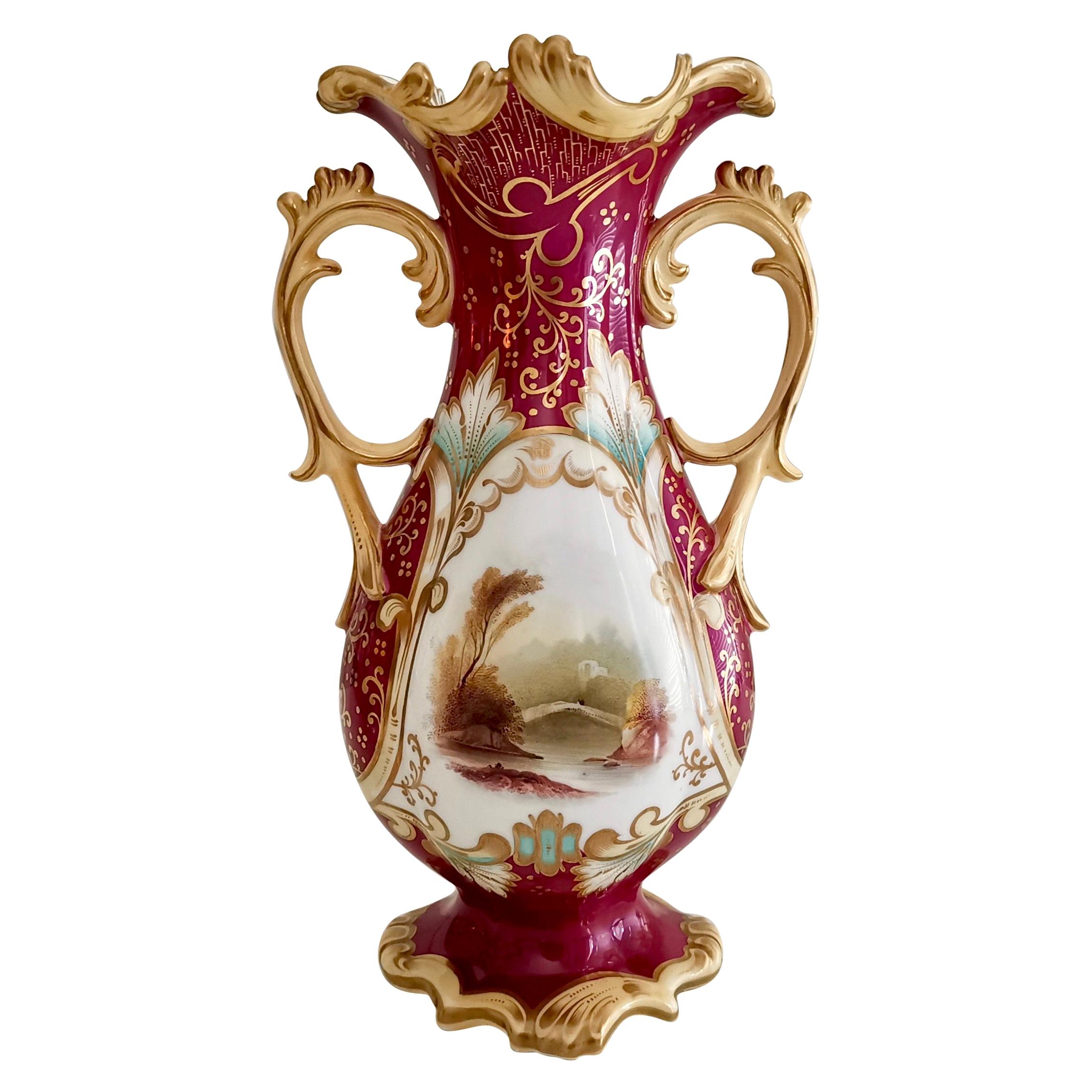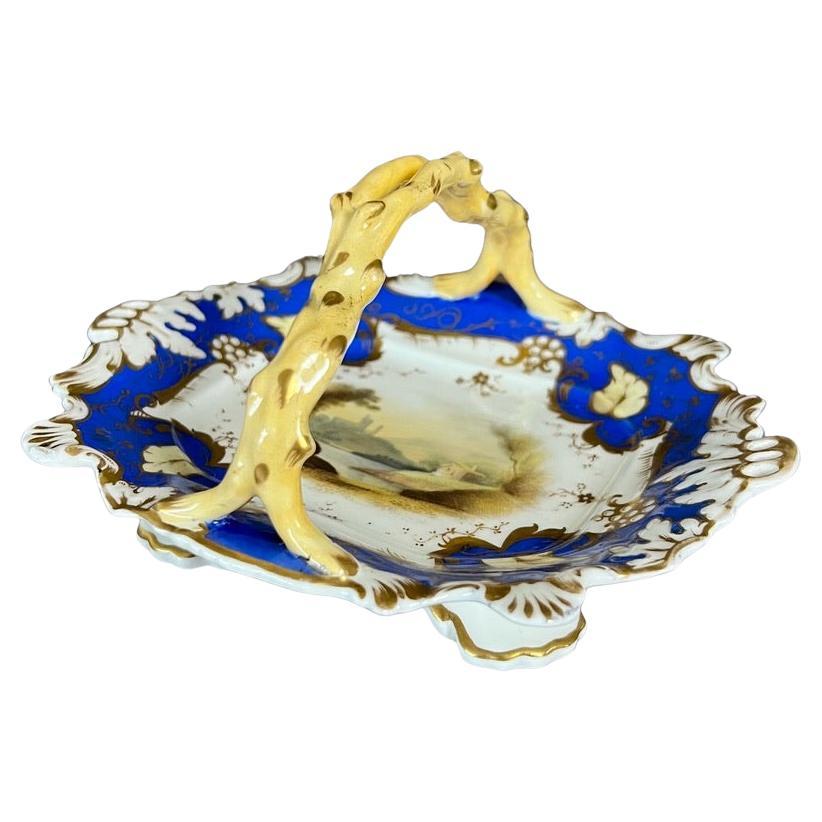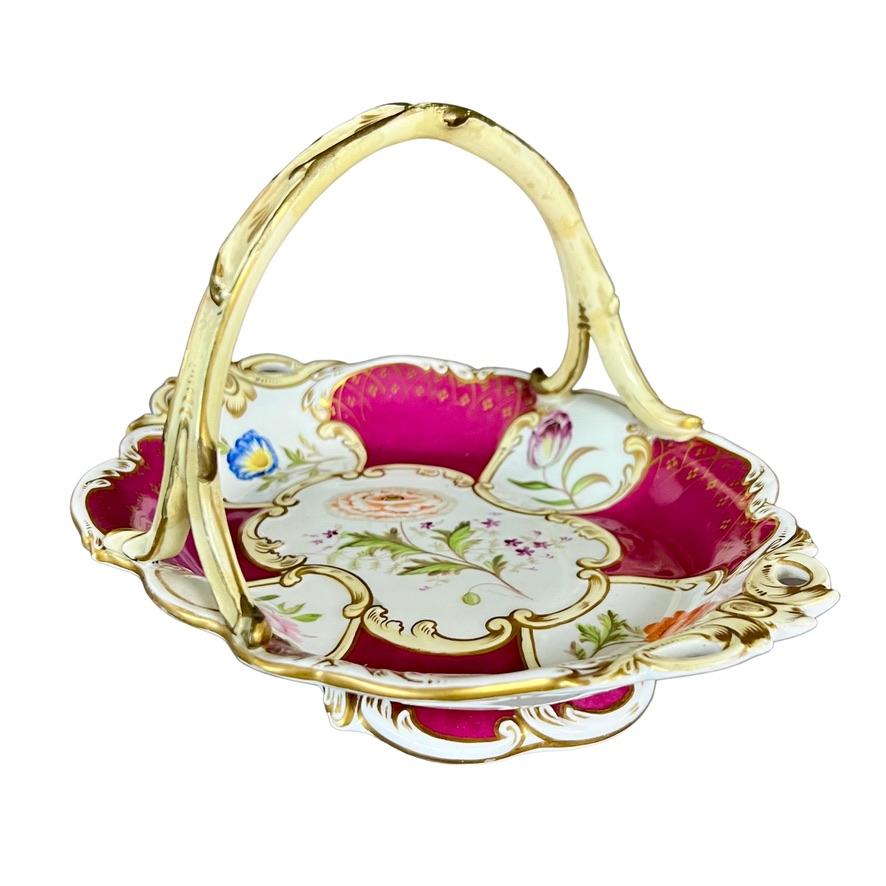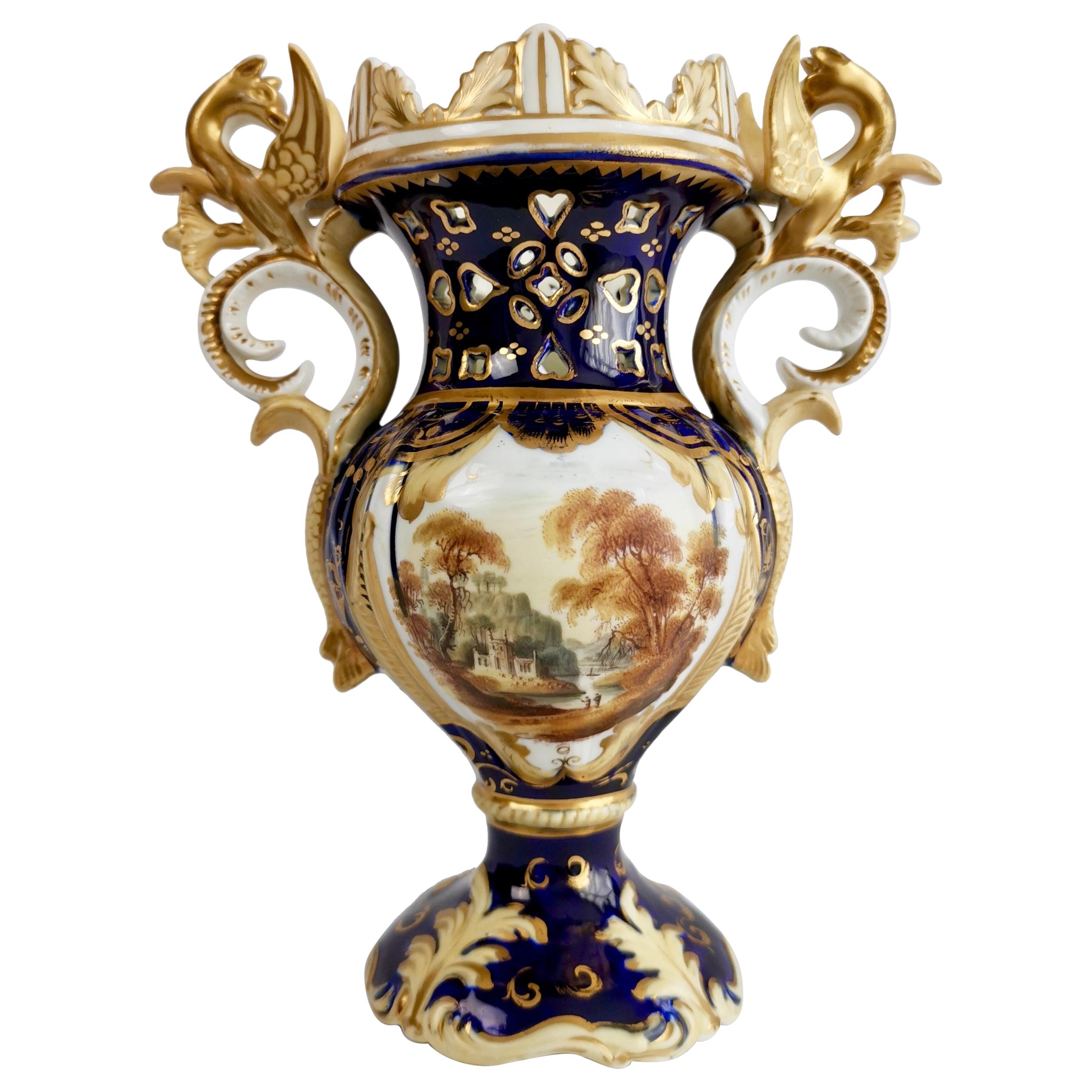Items Similar to Samuel Alcock Writing Desk Set Coalbrookdale Porcelain Encrusted Flowers, ca1830
Want more images or videos?
Request additional images or videos from the seller
1 of 19
Samuel Alcock Writing Desk Set Coalbrookdale Porcelain Encrusted Flowers, ca1830
About the Item
A complete writing desk set in the Coalbrookdale style with lavishly encrusted flowers, consisting of a tray, an inkwell with inner liner and double cover, a pen holder, and a blot holder.
This item is sold "As Found" (A/F) as it has some repairs; this is reflected in the price. The repairs are sympathetic but oldfashioned and the foot of this item is held up by a stand-in; if desired this can be redone invisibly by our excellent associated restorer at true cost, however this could take a few months.
Pattern no. unknown
Year: ca 1830-1835
Size: 34cm X 21cm (13.5” X 8.25”)
Condition: the base has been broken and restored with improvised foot underneath; some typical small losses to encrusting.
The Samuel Alcock factory was operative in Staffordshire between 1822 and 1856, after which it was bought by Sir James Duke and Nephews. The factory started as a partnership between the young Samuel Alcock and the older Ralph Stevenson, who provided the factory and capital. Alcock quickly took the factory to great heights, building one of the biggest factories of its time. Alcock jumped on the new Rococo Revival fashion and served a huge new middle class market. The reason we now don't hear much about Samuel Alcock porcelain is that much of it has been mis-identified over the years and attributed to Coalport, Ridgway, Rockingham or others; Alcock did not mark any of his porcelain save a few rare pieces, and the numbering system is difficult to understand. However, the wares are still wide spread and many are of great quality.
This set forms part of the Murray Pollinger Collection of Samuel Alcock Porcelain.
Murray Pollinger was a passionate collector of Samuel Alcock porcelain. He was known as a true gentleman, impeccably dressed, always kind and modest - even some of his porcelain collecting friends had no idea about the size and importance of his collection. From the mid 1980s until shortly before his death in 2022 he collected many thousands of pieces and painstakingly catalogued them. He also went on trips to Staffordshire to discover the history of Samuel Alcock from whatever little documentation has been preserved. Through his painstaking work, Pollinger was able to make sense of the pattern numbering system that was used, and this was a huge step forward in identifying and understanding the porcelain. A website with the results of his research will be made available over the course of 2023. While he sold off about half of his collection in 2016, the remaining half is now made available to a new generation of collectors.
Antique British porcelain is never perfect. Kilns were fired on coal in the 1800s, and this meant that china from that period can have some firing specks from flying particles. British makers were also known for their experimentation, and sometimes this resulted in technically imperfect results. Due to the shrinkage in the kiln, items can have small firing lines or develop crazing over time, which should not be seen as damage but as an imperfection of the maker's recipes, probably unknown at the time of making. Items have often been used for many years and can have normal signs of wear, and gilt can have signs of slight disintegration even if never handled. I will reflect any damage, repairs, obvious stress marks, crazing or heavy wear in the item description but some minor scratches, nicks, stains and gilt disintegration can be normal for vintage items and need to be taken into account.
There is widespread confusion on the internet about the difference between chips and nicks, or hairlines and cracks. I will reflect any damage as truthfully as I can, i.e. a nick is a tiny bit of damage smaller than 1mm and a chip is something you can easily see with the eye; a glazing line is a break in the glazing only; hairline is extremely tight and/or superficial and not picked up by the finger; and a crack is obvious both to the eye and the finger. Etcetera - I try to be as accurate as I can and please feel free to ask questions or request more detailed pictures!
- Creator:Samuel Alcock & Co. (Maker)
- Dimensions:Height: 4 in (10.16 cm)Width: 13.5 in (34.29 cm)Depth: 8.25 in (20.96 cm)
- Sold As:Set of 7
- Style:Rococo Revival (Of the Period)
- Materials and Techniques:
- Place of Origin:
- Period:
- Date of Manufacture:circa 1840
- Condition:Repaired: the base has been broken and restored with improvised foot underneath; some typical small losses to encrusting. Wear consistent with age and use. Minor losses. Minor structural damages.
- Seller Location:London, GB
- Reference Number:
About the Seller
5.0
Platinum Seller
These expertly vetted sellers are 1stDibs' most experienced sellers and are rated highest by our customers.
Established in 2016
1stDibs seller since 2019
208 sales on 1stDibs
Typical response time: 1 hour
- ShippingRetrieving quote...Ships From: London, United Kingdom
- Return PolicyA return for this item may be initiated within 14 days of delivery.
More From This SellerView All
- Samuel Alcock Porcelain Coffee Cup, Orange Imari Flowers, Rococo Revival ca 1830By Samuel Alcock & Co.Located in London, GBThis is a beautiful coffee cup and saucer made by Samuel Alcock around 1830, which was the Rococo Revival era. The set is decorated with a bold Imari pattern and has a "ring-moulded" shape. Samuel Alcock was one of the many potters in Staffordshire such as Spode, Coalport, H&R Daniel and many others during the 1830s and 1840s. He was perhaps not the most well-known of potters but produced very high quality wares and original designs, often standing out for their bright choice of colours and beautiful shapes. The Alcock factory is not well documented so although they had a huge output, items are often mis-identified and we don't know much about the production process of artists, even though the wares have a very high quality that equals that of the more well known factories. The Rococo style was originally a style of the 18th Century. After the Baroque style, which was highly symmetrical and well-designed as it aimed to express the perfection of God, the Rococo style was a reaction that expressed the unpredictability and flow of nature. "Rococo" is derived from the French word "rocaille", which stands for a mass of pebbles that are self-organised in a completely unpredictable mess, for instance on the beach or in the mountains. Rococo moved away from the stranglehold that religion had on the arts: it was capricious, asymmetrical, charming and worldly. As Europe got mired in various wars between Germany, France and Britain, the general style got much more austere again and people embraced neo-classicism. But in the 1830s and 1840s, the seemingly unlimited fortunes of the Industrial Revolution sparked a revival of Rococo, once again creating natural shapes that are not always symmetrical and don't particularly make rational sense. This coffee cup can...Category
Antique 1830s English Rococo Revival Tea Sets
MaterialsPorcelain
- Samuel Alcock Porcelain Vase, Maroon with Landscapes, Rococo Revival, ca 1840By Samuel Alcock & Co.Located in London, GBOn offer is a beautiful porcelain vase made by Samuel Alcock circa 1840 during the Rococo Revival era. It has a maroon ground and a stunning landscape painting. Samuel Alcock was on...Category
Antique 1840s English Rococo Revival Vases
MaterialsPorcelain
- Samuel Alcock Potpourri Vase, Green, Double Cover, Landscape, Flowers, ca 1835By Samuel Alcock & Co.Located in London, GBA potpourri vase with double cover, pale yellow/beige ground with apple green details, Rococo shape with fruit finial and scroll handles and foot; a flower reserve on one side and a ...Category
Antique 1830s English Rococo Revival Vases
MaterialsPorcelain
- Samuel Alcock Porcelain Basket, French Blue, Landscape, Rococo Revival ca 1830By Samuel Alcock & Co.Located in London, GBA small porcelain basket in Rococo Revival style with scroll and shell moulded borders, pierced handles on both ends, a pale yellow twig handle, a French blue ground with pale yellow foliage and a fine landscape painting in the centre. This would make a perfect gift as a trinket dish - these baskets were often used to collect visting cards from guests. Pattern unknown Year: ca 1830 Size: 17.5cm (6.8”) long, 9cm (3.5”) tall Condition: excellent The Samuel Alcock factory was operative in Staffordshire between 1822 and 1856, after which it was bought by Sir James Duke and Nephews. The factory started as a partnership between the young Samuel Alcock and the older Ralph Stevenson, who provided the factory and capital. Alcock quickly took the factory to great heights, building one of the biggest factories of its time. Alcock jumped on the new Rococo Revival fashion and served a huge new middle class market. The reason we now don't hear much about Samuel Alcock porcelain...Category
Antique 1830s English Rococo Revival Decorative Baskets
MaterialsPorcelain
- Samuel Alcock Matched Solitaire Porcelain Tea Set, Pink with Flowers, ca 1836By Samuel Alcock & Co.Located in London, GBA matched solitaire tea set consisting of a teapot with cover, a sucrier with cover, a milk jug and a matched trio consisting of a teacup, a coffee cup and a saucer. With pink ground...Category
Antique 1830s English Rococo Revival Tea Sets
MaterialsPorcelain
- Samuel Alcock Porcelain Basket, Rococo Revival, Maroon, Flower Reserves, ca 1835By Samuel Alcock & Co.Located in London, GBA maroon ground basket in Rococo Revival style with pierced pale yellow ends, a twig handle and five flower reserves with single flowers. Pattern 2/5610 Year: ca 1835 Size: 22.5cm (8.75”) long, 13cm (5”) tall Condition: handle has been repaired, see last picture; some rubbing This basket forms part of the Murray Pollinger Collection of Samuel Alcock Porcelain...Category
Antique 1830s English Rococo Revival Decorative Baskets
MaterialsPorcelain
You May Also Like
- Antique Pair English Porcelain Green Samuel Alcock Vases Urns Still Life FlowerLocated in Dublin, IrelandAn exceptionally fine quality identical pair of English rococo revival twin handle mantle vases, firmly attributed to Samuel Alcock, circa second quarter of the 19th century. Eac...Category
Antique 19th Century English Rococo Revival Urns
MaterialsCeramic, Porcelain
- Antique Dresden Potschappel Porcelain Flower Encrusted Bottle Neck VaseBy Dresden Porcelain, Jacob Petit, Meissen PorcelainLocated in Philadelphia, PAA fine antique Dresden porcelain vase. By Thieme Potschappel. Decorated throughout with encrusted porcelain flowers and painted scenes. One side of the bottle is painted with flowers, the other with a scene of 3 children in colonial/medieval garb. With gilt highlights. Simply a lovely porcelain vase! Date: 20th Century Overall Condition: It is in overall good, as-pictured, used estate condition with no chips, cracks, or repairs. Condition Details: There are typical losses to the flowers & foliage. Otherwise, there are some fine & light surface scratches and other signs of expected light wear consistent with age. Marks: Marked to the base with a Thieme...Category
20th Century German Rococo Vases
MaterialsPorcelain
- Antique Dresden Potschappel Porcelain Miniature Flower Encrusted Perfume BottleBy Dresden Porcelain, Meissen PorcelainLocated in Philadelphia, PAA fine antique miniature Dresden porcelain perfume bottle. By Thieme Potschappel. Decorated throughout with encrusted porcelain flowers...Category
20th Century German Rococo Porcelain
MaterialsPorcelain
- Antique KPM Royal Berlin Porcelain Flower Encrusted Reticulated Fruit BasketBy Königliche Porzellan-Manufaktur (KPM)Located in Philadelphia, PAA very fine, antique KPM porcelain flower encrusted fruit basket. With traditional twig form handles and feet, an openwork body, flower encrus...Category
Antique 19th Century German Rococo Planters, Cachepots and Jardinières
MaterialsPorcelain
- Antique Paris Porcelain Flower Encrusted or Schneeballen Bottle by Jacob PetitBy Jacob PetitLocated in Philadelphia, PAA rare, antique French porcelain bottle or decanter by Jacob Petit. With typical Meissen style "Schneeballen" overall flower encrusted decoration, figural flower encrusted handles...Category
Antique 19th Century French Rococo Bottles
MaterialsPorcelain
- Antique Meissen Porcelain Vase with Hand-Painted Flowers, Ca 1900Located in Copenhagen, DKAntique Meissen porcelain vase with hand-painted flowers. Purple and gold decoration. Ca. 1900. Measures: 19.5 x 11 cm. In excellen...Category
Early 20th Century German Biedermeier Vases
MaterialsPorcelain
Recently Viewed
View AllMore Ways To Browse
Samuel Alcock Porcelain
Porcelain Pen Tray
Vintage Green Carnival Glass
Zeleznobrodske Sklo
Arzberg Hutschenreuther Germany
Bitossi Onion
Blue Gulvase
Carrot Vase
Edgar Bockman
Green Carnival Glass
Hutschenreuther Arzberg
Manifattura Artistiche
Medina Glass
Nippon Moriage Vase
Noritake Hand Painted Vase
Object Refinery
Russel Wright Vase
Santa Clara Blackware





